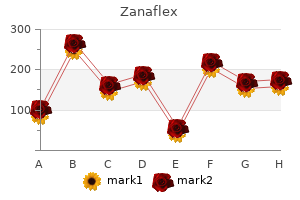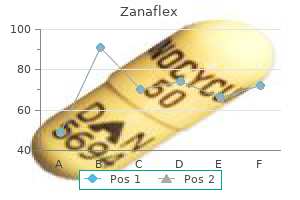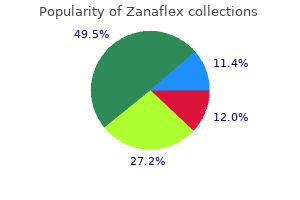

 5100 Springfield St. Suite 108, Dayton, Ohio 45431-1274
5100 Springfield St. Suite 108, Dayton, Ohio 45431-1274Zanaflex
"Purchase zanaflex 4 mg with mastercard, muscle relaxant medications".
By: A. Runak, M.A., M.D., M.P.H.
Associate Professor, University of Utah School of Medicine
Patterns of Spread of Disease from the Small Intestine 11 Introduction the small intestine consists of the duodenum muscle relaxer x buy zanaflex 2 mg otc, jejunum muscle relaxant starting with z purchase zanaflex 2 mg overnight delivery, and the ileum spasms muscle order zanaflex 4mg otc. In this chapter, we shall describe the patterns of disease spread involving the jejunum and ileum, and the appendix. Embryology and Anatomy of the Small Intestine the midgut develops into the third and fourth segments of the duodenum, the small intestine, and part of the large intestine. In the early fetus, the midgut connects directly to the yolk sac through a wide opening. After formation of the abdominal cavity, three important processes occur:1,2 proximal segment of the midgut to locate and fold in the left side, and the middle and distal segments in the right side of the abdominal cavity. The most distal segment remains in the upper abdominal cavity connecting to the hindgut, which is fixed to the left side of the posterior wall. Formation of the mesentery of the small intestine: the elongated midgut tube folds in the abdominal cavity while its peritoneal attachment is fixed to the posterior peritoneal wall and does not elongate at a similar length to the gut tube, resulting in formation of the mesentery that looks like a ruffle. The second and third segments of the duodenum are considered a ``secondary' extraperitoneal organ. They are covered by the posterior peritoneal layer that forms the root of the transverse mesocolon. The fourth segment of the duodenum emerges through an opening to become the duodenojejunal flexure and the jejunum. The jejunum folds in the left side of the abdominal cavity below the left side of the transverse mesocolon and anterior to the left kidney. The jejunum has a thicker wall than the ileum and has thickened mucosa folds, known as plicae circulares (valvulae conniventes). Rotation of the midgut: As elongation and migration progress, the peritoneal attachment of the gut tube rotates in a counterclockwise direction along the plane from the root to the gut tube, allowing the M. Patterns of Spread of Disease from the Small Intestine the ileum tends to have a thinner wall and occupies the lower abdominal cavity and the right side of the abdomen. The mesentery of the small intestine consists of two peritoneal layers suspending the jejunum and ileum in the peritoneal cavity. The root of the mesentery (about 15 cm in length) is formed from the posterior peritoneal layer covering the ascending colon and its mesocolon and that covering the descending colon and its mesocolon. This posterior peritoneal layer is also continuous with the posterior peritoneal layer of the transverse mesocolon. The root of the mesentery starts from the duodenojejunal flexure on the left aspect of the abdominal aorta just caudal to the root of the transverse mesocolon, coursing diagonally to the right sacroiliac joint, traversing anterior to the third part of the duodenum, aorta and inferior vena cava, right ureter, and the right psoas muscle. The mesentery of the jejunum carries the arteries, veins, lymphatic vessels, and nerves of the jejunum. The duodenojejunal flexure and left paraduodenal recess where the fourth segment of the duodenum emerges from the extraperitoneum can be defined on imaging studies by following these anatomic landmarks: the inferior mesenteric vein forms the left and superior boundary and can be defined as a superior duodenal fold. The vein is covered by the medial edge of the posterior peritoneal layer covering the descending colon. This vein also forms the landmark of the root of the transverse mesocolon, which is just cephalad to the duodenojejunal flexure. Several proximal branches of the jejunal arteries, with accompanying veins in the jejunal mesentery, form the anterior boundary.

However spasms pregnancy order zanaflex 2mg, their protean imaging manifestations are legendary and diagnosis may be difficult muscle relaxant used in dentistry best 4mg zanaflex. There are several mechanisms of spread: Tumor spreads by direct invasion of the liver spasms behind knee zanaflex 2 mg mastercard, kidneys, or inferior vena cava. Hematogenous spread is to the liver, lungs, and bones and lymphatic spread is to the paraaortic lymph nodes. The mechanisms of spread are direct spread and subperitoneal with venous invasion, lymphatic spread, and hematogenous spread. Direct extension within the extraperitoneum is along the renal vessels to encase the aorta and encase or invade the inferior vena cava and/or renal veins. Further spread involves the anterior pararenal space to include the bare area of the liver, duodenum, pancreas, and colon. Subperitoneal spread may continue to the mesenteries along the scaffold of the celiac artery and superior mesenteric artery. Pheochromocytomas Pheochromocytomas arise from the chromaffin cells of the adrenal medulla. Chromaffin cell tumors at other sites of origin are referred to as paragangliomas or chemodectomas. These tumors are of neural crest origin, whose cells with normal development form sympathetic ganglion cells. The relative tumor cell maturity ranges from well-differentiated cells (benign ganglioneuroma) to immature cells (neuroblastoma). The tumor is infiltrating the subperitoneal space displacing the right kidney posterolaterally (arrowhead) and invading the portal hepatis displacing the portal vein (P). Other intraabdominal sites include the celiac ganglion, superior mesenteric ganglion, and paravertebral sympathetic ganglia. The most common mechanism of spread is direct extension within the subperitoneal space. The tumor infiltrates into the surrounding areolar tissue of the extraperitoneum, most often the perirenal space. It then encases and grows along the scaffold of the vascular structures, frequently infiltrating the renal hilum, displacing the kidney and 326 a 13. Subperitoneal spread can continue along the celiac artery, superior mesenteric artery, and their branches, gaining direct access to the gastrohepatic ligament, the hepatoduodenal ligament, and small bowel mesentery. This allows for direct spread into the liver, extension to and through the esophageal hiatus, and permeation of the small intestine mesentery. The aggressive infiltrating nature of neuroblastoma and its use of the subperitoneal space explain the frequent presentation across the midline. Hematogenous spread may be early or late in the disease and is most common to the bones and skin. Neuroblastoma with extensive subperitoneal space extension and spread to the thorax. The tumor spreads to the renal hila with displacement of the kidneys and obstruction of the renal collecting systems (arrows). Rouviere O, Brunereau L, Lyonnet D, Rouleau P: Staging and follow-up of renal cell carcinoma. Sengupta S, Zinche H: Lessons learned in surgical management of renal cell carcinoma. Jaffe N: Neuroblastoma: Review of the literature and an examination of factors contributing to its enigmatic character. Sheth S, Syed A, Fishman E: Imaging of renal lymphoma: Patterns of disease spread with pathologic correlation.

The AngioJet catheter is activated in a slow advancement mode along the entire length of the target thrombus in an antegrade and retrograde fashion quick spasms in lower abdomen order 2mg zanaflex free shipping. It can be combined with direct pharmacolytic therapy in activation mode using the "pulsed spray technique muscle relaxant vecuronium buy zanaflex overnight delivery. In the presence of a large thrombus burden or resistant clot gastric spasms buy 2 mg zanaflex overnight delivery, the administration of lytics selectively into the target vessel in conjunction with the AngioJet has been studied. It safely ablates underlying atherosclerotic plaque and facilitates subsequent stent placement. This device promotes rapid thrombus clearance and suppresses platelet aggregation. Patient Preparation Routine patient preparation and anticoagulation for percutaneous intervention are required. The latest laser catheters have improved fiber array with concentric or eccentric tip configuration. The eccentric catheters are reserved for circumferential debulking in in-stent stenosis lesions for markedly eccentric lesions. The computer lasing program within the laser console limits each lasing train to 5 seconds, except for 10 seconds with the X-80 0. The patient and the catheterization laboratory staff should wear special protective goggles. Results Laser angioplasty has been studied in acute coronary and peripheral ischemic syndromes for thrombus-laden lesions, in-stent restenosis, and chronic total occlusions. This includes interventions in native coronary vessels; saphenous vein grafts; calcified, nondilatable lesions; and chronic total occlusions. In the era of drug-eluting stents, these devices are frequently used as part of a prestenting strategy. Practical Pearls the catheterization laboratory staff should be familiar with preparation of the relevant niche devices. An Amplatz left guide catheter is useful for technically demanding left coronary interventions. For intervention in an anatomically challenging right coronary artery, both Amplatz right or Amplatz left shapes can provide adequate support. This will significantly enhance subsequent device delivery and improve its utilization. Current role of emboli protection devices in percutaneous coronary and vascular interventions. Randomized trial of a distal embolic protection device during percutaneous intervention of saphenous vein aorto-coronary bypass grafts. Removal of focal atheromatous lesions by angioscopically guided high-speed rotary atherectomy. An evidence-based approach to the use of rotational and directional coronary atherectomy in the era of drug-eluting stents: when does it make sense Adjunctive mechanical devices to prevent distal embolization in patients undergoing mechanical revascularization for acute myocardial infarction: a metaanalysis of randomized trials. Role of adjunctive thrombectomy and embolic protection devices in acute myocardial infarction: a comprehensive meta-analysis of randomized trials.

Many permanent pacing leads are constructed with fixation devices (screws spasms rib cage area cheap 4mg zanaflex with visa, tines spasms quadriceps discount zanaflex 4 mg otc, or barbs) that help guarantee long-term contact with the endocardium muscle relaxer kidney order zanaflex us. Temporary pacing leads are not constructed with fixation devices so they can be easily removed when pacing is no longer required. Ventricular tachycardia or ventricular fibrillation may be induced if the pacing stimulus falls during the vulnerable period of the cardiac cycle. Demand mode (synchronous) - A demand pacemaker paces only when the heart fails to depolarize on its own (fires only "on demand"). A pacemaker system may be single- or dual-chamber: Single-chamber - A single-chamber pacemaker system uses one lead inserted into either the right atrium or the right ventricle. If a single-chamber atrial pacemaker senses a P wave, the pacemaker is inhibited from firing an electrical stimulus. If it does not sense a P wave, the pacemaker sends an electrical stimulus to the atrium. Single-chamber ventricular pacing is the most commonly used temporary type of pacing and is also frequently used for permanent pacing. Singlechamber atrial or ventricular pacing can be used with epicardial pacing wires. Dual-chamber - A dual-chamber pacemaker system uses two leads, one going to the right atrium and the other A B C Figure 10-2. If a dual-chamber pacemaker senses a P wave, the pacemaker is inhibited from firing an electrical stimulus. If the pacemaker does not sense a P wave, the pacemaker sends an electrical stimulus to the atrium. Figure 10-2, example C, shows stimulation of the atria and the ventricle by a dual-chamber pacemaker. Dual-chamber pacemakers are frequently used with permanent pacing and can also be used with epicardial pacing. Dual-chamber temporary pacing can be done, but it is difficult to place temporary atrial wires and it is not as reliable as ventricular pacing. This is because the primary problem in these situations is the inability of the myocardium to contract when appropriately stimulated. They should be used only as a temporary measure in emergency situations until transvenous access is available or the cause of the bradyarrhythmia is resolved. Transvenous pacing is still the treatment of choice for patients requiring a temporary but longer period of pacemaker support. Multifunction pads have the capability to monitor the heart rhythm, externally pace, and defibrillate through one set of pads. The pads have conductive gel on the inner surface to help transmit the electrical current through the chest wall. The large surface area of the pad and the conductive gel also help minimize the possibility of skin burns from the procedure. If possible, excess hair should be clipped before the pads are applied to maximize contact with the skin surface.
Zanaflex 2mg. RELAXATION MUSIC - Om mantra 30 minutes meditation with ocean sound for study.